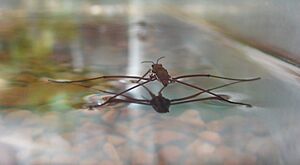Surface energy facts for kids
Imagine a tiny world where everything is made of super-small building blocks called molecules. In liquids, these molecules are always moving around, but they also like to stick together! This is why a glass of water stays together and doesn't just fall apart into individual molecules.
Contents
Why Do Liquids Stick Together?
Molecules in a liquid have a special kind of attraction to each other. Think of them like tiny magnets, but instead of metal, they are attracted to other molecules. This attraction is called an intermolecular force. It's like an invisible glue that holds the liquid together.
When a molecule is deep inside a liquid, it's surrounded by other molecules pulling on it from all sides. These pulls balance each other out. But what about the molecules right at the surface?
Molecules at the Surface
Molecules on the surface of a liquid are different. They only have other molecules pulling them from the sides and from below. There are no molecules above them to pull them upwards. This means the molecules at the surface are pulled inwards, towards the rest of the liquid. This inward pull creates something called surface energy.
Surface energy is like the extra energy that molecules at the surface have because they are not completely surrounded. It's why a liquid tries to have the smallest possible surface area. For example, a drop of water on a waxy leaf tries to form a perfect sphere because a sphere has the smallest surface area for its volume.
What is Evaporation?
You know how puddles disappear on a sunny day? That's called evaporation. For a liquid molecule to escape from the liquid and turn into a gas (like water vapor), it needs a lot of energy. It has to break free from all those sticky attractions holding it to its neighbors.
The energy needed to make a liquid evaporate is called the heat of evaporation. For water, it takes a lot of energy – about 40 kilojoules for every mole of water! This is why sweating helps cool you down: when sweat evaporates from your skin, it takes a lot of heat energy with it.
Surface Tension: A Related Idea
Surface energy is closely related to something you might have heard of: surface tension. Surface tension is the "skin" or "film" that seems to be on the surface of a liquid. It's what allows light objects, like a paperclip or some insects (like water striders), to float on water without sinking, even though they are denser than water.
This "skin" is created by the strong inward pull on the surface molecules. They are packed tightly together and resist being pulled apart. So, surface tension is really just the force that comes from the surface energy trying to make the liquid's surface as small as possible.
See also
 In Spanish: Energía superficial para niños
In Spanish: Energía superficial para niños
Images for kids



